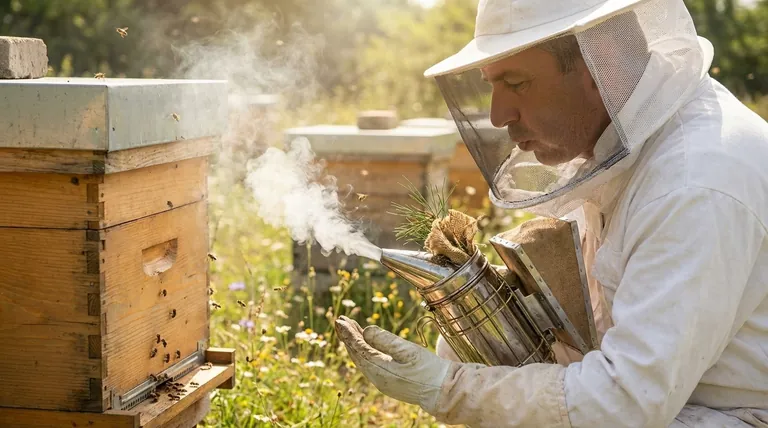In the event of a bee sting, smoke is used to mask the alarm pheromones that are released at the sting site. A honey bee's sting isn't just a physical attack; it's a chemical signal that marks a target and incites other bees to defend the colony. By applying smoke to the stung area, you disrupt this chemical communication, preventing a single sting from escalating into a coordinated defensive response.
A bee sting releases a potent "alarm" pheromone that acts like a bullseye for other bees. Smoke effectively jams this signal, preventing a small incident from triggering a widespread colony attack.

Understanding Bee Communication: The Role of Pheromones
To understand why smoke works, you first have to understand how bees communicate. Their world is largely governed by chemical signals called pheromones.
The Sting as a Chemical Signal
When a honey bee stings, its stinger releases a potent alarm pheromone. This chemical has a distinct scent, often compared to bananas, that serves a critical purpose for the colony's defense.
The "Attack Here" Command
This alarm pheromone is not a passive byproduct; it is an active signal. It effectively tells other guard bees, "The threat is here! Attack this spot!" This is why one sting, if left unmanaged, often leads to many more in the same location.
How Smoke Disrupts Chemical Signals
Smoke is a powerful tool precisely because it interferes with this primary mode of bee communication. It works on multiple levels to de-escalate a defensive situation.
Masking the Alarm Pheromone
The primary function of smoke after a sting is to overwhelm the bees' senses. The strong scent and particulate matter in the smoke effectively "hide" the alarm pheromone molecules, making it difficult for other bees to detect the signal and locate the target.
Triggering a Distraction Response
Smoke also triggers a deeper, instinctual response. Bees associate smoke with fire, a major threat to their hive. Their immediate instinct is to prepare to abandon the hive by consuming large amounts of honey.
Reducing Agility and Aggression
A bee that has gorged on honey has a physically distended abdomen, making it more difficult to flex its body into the proper position for stinging. This feeding response distracts them from defensive duties and makes them less agile and less likely to attack.
Understanding the Trade-offs
While smoke is an essential beekeeping tool, its effectiveness depends on proper application. Misuse can create more problems than it solves.
Smoke Is Not a Magic Bullet
Smoke is a management tool, not a guarantee against stings. A highly defensive or agitated colony may still sting despite the presence of smoke. It calms bees but does not make them docile.
Proper Technique Is Crucial
Too much smoke can be counterproductive. It can agitate the bees, cause them to become frantic, and drive them away from the frames you need to inspect. The goal is to use cool, gentle puffs, not a hot, dense cloud.
Addressing the Root Cause of Aggression
If a colony is consistently aggressive, smoke is only a temporary solution. Constant defensiveness can be a sign of underlying problems like a failing queen, mite infestation, or genetic disposition. These issues must be addressed directly.
How to Apply This to Your Beekeeping
Your use of smoke should be intentional and based on the specific situation you are facing.
- If you are preparing for an inspection: Apply a few gentle puffs of smoke at the hive entrance and under the lid to disrupt communication before the bees become agitated.
- If you have just been stung: Immediately remove the stinger and apply cool smoke directly to the stung area on your suit or skin to mask the alarm pheromone.
- If the colony becomes highly agitated during an inspection: Use gentle puffs to interrupt their defensive coordination and create a calmer environment to continue your work or safely close the hive.
By understanding how bees communicate, you can use smoke not just as a brute-force tool, but as a sophisticated method for managing and influencing colony behavior.
Summary Table:
| Scenario | Purpose of Smoke | Recommended Action |
|---|---|---|
| Preparing for hive inspection | Disrupt communication before agitation | Apply gentle puffs at hive entrance and under lid |
| Immediately after a sting | Mask alarm pheromones at sting site | Remove stinger and apply cool smoke to affected area |
| During agitated inspection | Interrupt defensive coordination | Use gentle puffs to calm bees and continue work safely |
Upgrade Your Beekeeping Safety & Efficiency with HONESTBEE
As commercial apiaries and equipment distributors know, proper bee management tools are essential for both safety and productivity. At HONESTBEE, we supply high-quality beekeeping supplies and equipment designed specifically for wholesale operations like yours.
Our smoke generators and protective gear help you effectively manage colony behavior while minimizing stings during inspections. By using professional-grade equipment from HONESTBEE, you can:
- Reduce defensive responses through proper smoke application
- Improve inspection efficiency and safety
- Maintain healthier, more productive colonies
Ready to enhance your beekeeping operations? Contact our wholesale team today to discuss your specific equipment needs and volume requirements.
Visual Guide

Related Products
- European Stainless Steel Bee Smoker for Honey Bee Hive
- Stainless Steel Honey Bee Smoker Hive and Honeycomb Smoker for Beekeeping
- Premium Traditional Copper Bee Smoker with Bellows
- Economy Galvanized Beekeeping Honey Bee Smoker for Wholesale
- Electric Bee Smoker European Style Bee Hive Smoker for Beekeeping
People Also Ask
- What are the differences between stainless steel and galvanized steel bee smokers? Choose the Right Smoker for Your Apiary
- What are the benefits of cleaning a bee smoker? Ensure Hive Safety and Bee Health
- What are the advantages of a high-quality bee smoker? Achieve Calm, Confident Hive Management
- What are the steps to operate a bee smoker? Master the Art of Gentle Beehive Management
- What are the features of a recommended bee smoker? A Guide to Safety, Durability & Performance



















